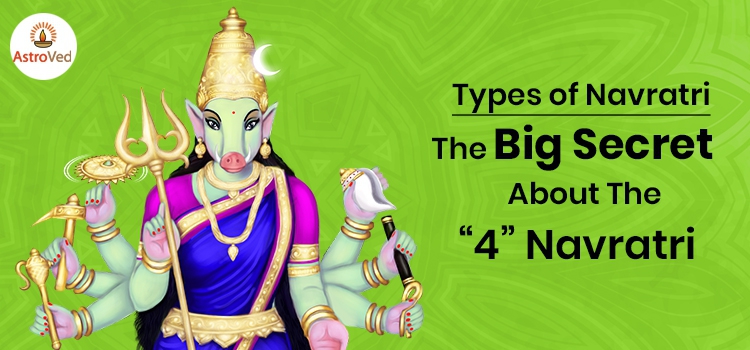The Big Secret About 4 Kinds Of Navaratri
4 Kinds of Navaratri – The 9 Goddess Power Nights:
Navaratri denotes the nine nights of the Goddess. It is the power time when the Divine feminine energy fills the earth plane and is ready to bestow her abundant blessings on her devotees. Although Navaratri is celebrated twice a year, most of us are unaware that there are 4 kinds of Navaratri mentioned in scriptures.
As per our sacred texts, the Supreme Goddess is worshipped and invoked in her powerful forms four times in a year; and hence, there are a total of 4 Navaratris in a year. They are:
- Sharada Navaratri (Oct-Nov)
- Chaitra Navaratri (Apr-May)
- Magha Navaratri (Jan-Feb)
- Ashada Navaratri (Jun-Jul)
Let us understand what each form of Navaratri denotes:

Sharada Navaratri:
Sharada Navaratri, also known as Shardiya Navaratri, is the most common Navaratri celebrated during the months of October to November. ‘Shardiya’ means autumn, and this period is usually the harvesting season. This Navaratri is also called ‘Maha Navaratri,’ as this Navaratri is believed to be the nine power nights when the Goddess fought and killed the demon Mahishasura. During this Navaratri, Goddess is usually worshipped in her nine powerful forms, known as Nava Durga. Worshipping the Goddess during Sharada Navaratri is believed to destroy both internal and external negative forces and bestow us with prosperity, wealth, happiness, and overall abundance. As per scriptures, this Navaratri is also considered the period when Rama killed Ravana. It is also believed that Rama worshipped Durga before waging war against Ravana. Hence, worshipping Goddess during this time can help you overcome obstacles and gain success in endeavors.
Chaitra Navaratri:
This is the second most famous Navaratri celebrated across the country, revering the Goddess. It is celebrated from the first day of the lunar month Chaitra (Mar-Apr), and lasts for nine days. Since this period also marks the beginning of the spring season, it is also called Vasant Navaratri. This Navaratri ends on the birthday of Rama – Rama Navami. So, this Chaitra Navaratri is also known by the name Rama Navaratri. The spring season marks the beginning of fresh blossom and vegetation, and this Navaratri is a favorable time to worship the Goddess for victory in new beginnings in life.
Magha Navaratri:
Magha Navaratri falls during the winter season during the lunar month of Magha (Jan-Feb). This Navaratri is widely called Vasant Panchami. This festival acts as preparation for the spring season and revering the Goddess for a wonderful spring and good harvest. It is believed that Magha Navaratri is dedicated to Saraswati, the Goddess of arts and wisdom. Goddess Saraswati symbolizes creativity, excellence in arts, music, and knowledge. Children who are about to commence their education, and students who wish to succeed in their exams can worship the Mother Goddess Saraswati during this Navratri for academic success and improving their acumen.
Ashada Navaratri:
Ashada Navaratri denotes the nine Goddess nights celebrated during the lunar month of Ashada (Jun-Jul). This marks the beginning of monsoon season, and the Goddess is worshipped by adequate rainfall during the season. This Navratri is also known as Varahi Navaratri, as the Goddess is propitiated as a boar-faced incarnation called Varahi. Varahi is a compassionate Goddess who is believed to fulfill the earnest wishes of her devotees. Worshipping her during Ashada Navaratri can destroy obstacles and sorrow, bestow material riches, and prosperity.
Science Behind Navaratri Celebration and Fasting:
All the four Navratri festivals are celebrated to honor the Goddess and also marks the change of seasons. It is believed that during a season change, our body and mind are affected both physically and psychologically. Hence, our ancient seers followed the rule of observing Vrat or fasting during these 4 Navaratris.
Observing a fast during these periods can help you strike a balance between your physical and psychological imbalance expected during this time. It also helps to detoxify and purify your system, thus keeping you healthy and fit. Hence, it is recommended to observe complete or partial fasting during these 4 Navaratri periods and spend your time worshiping the Goddess to eliminate both internal and external negativities and build a positive aura around you.
Let us take advantage of these awesome Goddess powertimes to connect with her and receive her abundant blessings.



















